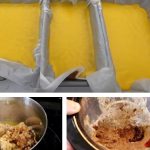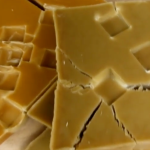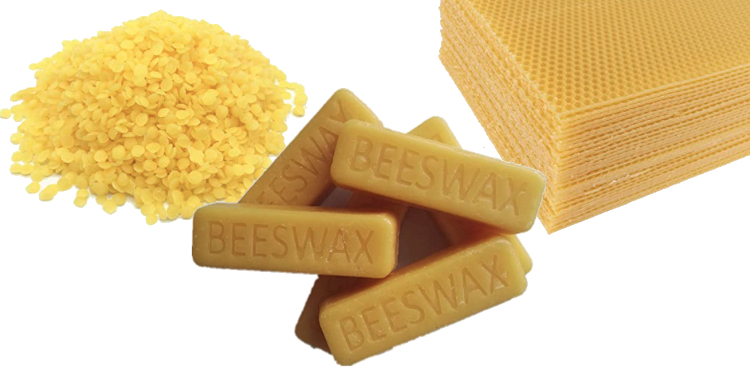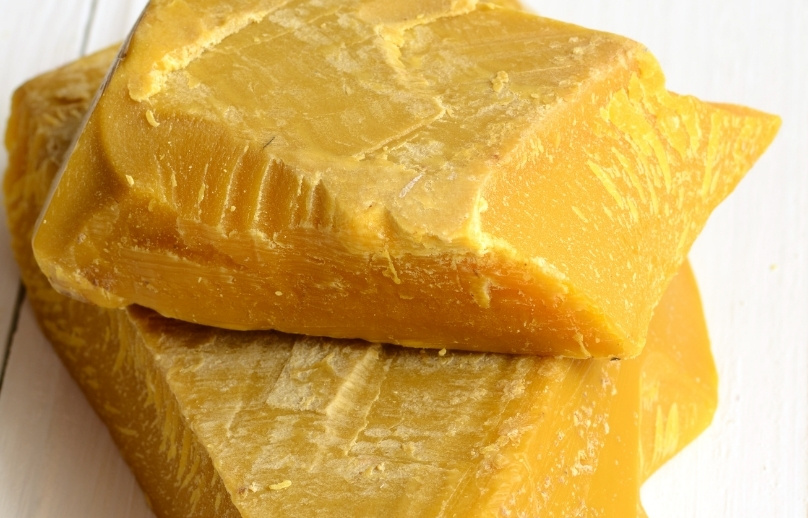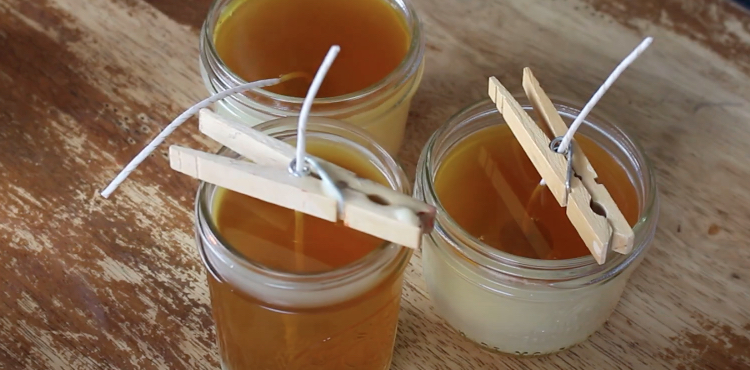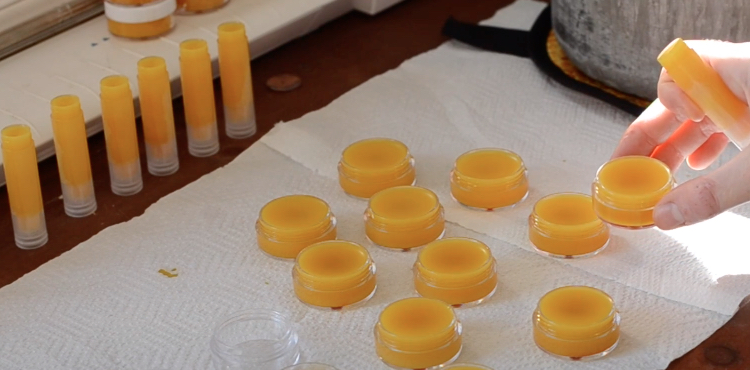Beeswax is a multi-purpose marvel and can serve many purposes in our daily lives. Not only is it an excellent material for creating clean-burning, long-lasting candles, but it has an appealing natural scent that brings a warm glow to any room.
It is great in cosmetics, forming a protective barrier that seals much-needed moisture into our skin without clogging pores, popular for lip balms, lotions and creams alike. There are so many ways you can use beeswax. I just love it!
Beeswax has a wide range of practical uses, such as making candles, waterproofing fabric, conditioning leather, and even as a key ingredient in cosmetics and skin care products. It is also used for lubricating wooden parts, seasoning cast iron pans, and creating salves and balms. Beeswax is amazing!
For help finding quality beeswax for your projects, check out my essential beeswax shopping guide.
Beeswax in Candle Making
Picture walking into a room filled with the soft glow and gentle fragrance of beeswax candles. Beeswax has been treasured for centuries as one of the finest materials for candle making.

Its clean-burning properties, remarkable longevity, and natural aroma make it an appealing choice for lighting up our homes and creating a warm, welcoming ambience.
Clean Burning: Unlike paraffin candles, which release toxins when burned, beeswax candles burn cleanly. This means you can enjoy your candle-lit atmosphere without worrying about filling your living space with harmful chemicals.
The gentle shimmer of beeswax candles has a soothing presence, and because they don’t produce the black soot often seen with paraffin candles, your walls and ceiling will stay free from unsightly residue.
The long burn time of beeswax candles is another reason why they are highly regarded. Not only do they last longer than many other types of candles, but they also emit a natural honey scent that fills the room with warmth and comfort.

For those interested in trying their hand at making beeswax candles, crafting your own beeswax candles can be an immensely rewarding and creative endeavor.
There are so many different molds available to suit your home decor style or just to make adorable candles with your kids.
If you’re interested in trying your hand at making beeswax candles, there are various resources available that provide comprehensive guides to help you through each step of the process.
Remember, when working with beeswax, it’s important to handle it gently as it can melt down quickly and may become challenging to work with if overheated.
The benefits of beeswax extend way beyond just its aesthetic appeal—the therapeutic and practical qualities make it an essential ingredient in the creation of light and warmth in our homes.
Cosmetic Applications of Beeswax
Beeswax is a remarkably versatile ingredient used in many cosmetic products like creams, chapstick, salves, balms, etc. It plays an important role in skincare routines due to its unique qualities that benefit the skin.

I think the most important benefits of beeswax is that it promotes cellular regeneration and healing of your skin. It’s a great ingredient to help with wrinkles, itchiness, irritation, psoriasis, and aging skin.
It can form a protective barrier on the skin, acting as a shield that locks in moisture while still allowing the skin to breathe. This makes it an ideal natural alternative for individuals with acne, sensitive or easily irritated skin.
Creams and Lotions
When used in creams and lotions, beeswax helps to create a smooth and creamy texture that glides effortlessly onto the skin, providing long-lasting hydration without leaving a greasy residue.
Unlike petroleum-based emollients, beeswax does not clog pores, making it suitable for all skin types. Additionally, it assists in soothing and softening the skin, making it especially beneficial for individuals dealing with dryness, rough patches, or conditions such as eczema or psoriasis.
Not only does beeswax offer valuable moisture-sealing properties, but it also contains vitamin A—a vital nutrient known for supporting healthy skin cell regeneration. This makes beeswax an effective ingredient for repairing and rejuvenating the skin, promoting a more youthful and radiant complexion over time.
Lip Balms
For those prone to chapped lips, beeswax shines as a key ingredient in lip balms. Its moisturizing and protective qualities help to maintain soft and supple lips while shielding them from harsh environmental elements. I can never go back to store bought chapstick after making my own with just coconut oil, beeswax, vitamin E and essential oils.
This natural emollient forms a nourishing layer that keeps delicate lip areas hydrated and prevents dryness and cracking.
In crafting your own beauty products at home, beeswax serves as an essential component due to its myriad benefits beyond moisturization. Its ability to provide structure and stability enables the creation of rich, luxurious creams and salves that deliver potent skincare benefits.
Balms and Salves
Beeswax is crucial in all my homemade balms and salves and is a great base for diaper rash creams. I could not live without my Jewelweed salve (essential for poison ivy and bug bites) or my plantain salve (for bee stings and mosquito bites). These go everywhere with me.
By incorporating beeswax into homemade concoctions, you can customize your beauty routines to cater to specific concerns while ensuring that their skincare essentials remain free from harmful synthetic chemicals.
The remarkable versatility of beeswax in cosmetic applications extends far beyond traditional skincare products. Here’s how this natural wonder contributes to various other personal care items that are part of our daily routines.
Crafting Homemade Skin Lotion
Making your own skin lotion at home can be a rewarding and creative process, especially when using beeswax as a natural ingredient. Not only does it allow you to customize the lotion according to your specific needs, but it also ensures that you know exactly what is going onto your skin. And it can save you a lot of money.
Beeswax, known for its emollient and protective properties, adds a rich, creamy texture to homemade lotions and acts as a barrier on the skin, sealing in moisture without clogging pores. This can be particularly beneficial for those with sensitive or dry skin.
It soothes itchiness and irritation, is great to use on wrinkles and other signs of aging skin, and it helps repair damaged skin and promote cellular regeneration.
Homemade skin balms are easy to make and your skin will love it. You’ll need beeswax, coconut oil, almond oil, and essential oils for fragrance if desired, along with a double boiler or glass bowl for melting the ingredients, and a storage container such as an 8 oz jar with a lid to store the finished product. Another popular recipe involves Tallow and beeswax. It’s worth looking into too.
One important thing to remember when working with beeswax is that it has a relatively high melting point, so using a double boiler or a glass bowl placed over a pot of boiling water helps prevent scorching.
Once you have all your ingredients ready, you can start creating your homemade skin lotion.
Here’s a Standard Skin Lotion Recipe
- Beeswax: 2 tablespoons
- Coconut oil: 1/2 cup
- Almond oil: 1/4 cup
- Essential oil (optional): 10-15 drops
The beeswax acts as an effective emulsifier, helping to bind water and oils together to ensure a stable mixture. When combined with coconut and almond oils, it creates a nourishing and hydrating base for the lotion.
The optional essential oils provide not only a pleasant scent but can also offer additional skincare benefits. Consider Frankincense, Lavender, or Rose. All have amazing benefits for your skin.
Once you have melted and combined the ingredients, pour the mixture into your storage container and let it cool. The result will be a rich and nourishing skin lotion that provides natural skincare benefits without any artificial additives or preservatives.
Homemade skin lotions using beeswax lock in moisture while allowing skin to breathe, promote smooth, supple and hydrated skin, help with cellular regeneration, and protect you from harsh environmental factors and weather.
So, why not try making your very own skin lotion? It’s an enjoyable way to engage in self-care, creating personalized organic skin care products, while reaping the benefits of natural skincare.
Preserving Wood with Beeswax
Another use of this amazing gift from honeybees is its use treating wood. Beeswax serves as a fantastic natural sealant and polisher, guarding wooden surfaces against moisture and wear. It not only protects the wood but also enhances its natural color and grain, providing a beautiful finish.

The process of preserving wood with beeswax is relatively simple and incredibly effective. The low melting point of beeswax makes it easy to apply, and its malleable nature allows it to be worked into the grain of the wood, creating a protective barrier and a great wood polish.
This barrier acts as a non-toxic shield against water, preventing moisture from permeating the surface of the wood that causes damage over time.
Whether it’s a cherished family heirloom, kitchen chairs, coffee table, or a newly acquired piece, the application of beeswax can work wonders in maintaining and enhancing the visual appeal of wooden items, providing a durable seal to preserve your furniture.
Incorporating other natural oils such as linseed oil with beeswax can result in a nourishing wood polish that not only protects but also enriches the wood’s natural appearance.

This combination helps maintain the integrity of the wood while also providing an additional layer of protection against wear and tear.
This process isn’t just about repair; it’s about restoration, transforming worn-out items into statement pieces that exude timeless beauty.
With its remarkable ability to safeguard and enrich wooden items, using a beeswax wood polish is a timeless practice that celebrates the inherent beauty and resilience of natural materials.
Beeswax in Enhancing Aromas
Beeswax isn’t just reserved for wood preservation and skincare; it also has a captivating role to play in the realm of scents and aromas. It gets its smell from nectar and honey originally stored in the honeycomb. Not surprisingly, it’s one of my favorite smells.
Beeswax actually helps to purify the air in your home. When used in candles or wax melts it releases negative ions into the air which then bind to positively charged particles in the air (like pollen, germs, or dust) that helps to neutralize these pollutants, creating a cleaner atmosphere.
This is a great option for people with allergies and asthma and a better choice than chemical based air fresheners, candles, and scented products.
Not only does beeswax smell amazing, like sweet honey powder or wildflowers, it also has calming and soothing properties, making it a great addition to your bedroom or part of any aromatherapy routine.
You can make or purchase beeswax candles or wax melts combined with essential oils, with additional aromatherapy benefits. Another great option is to make beeswax solid perfumes with a carrier oil (like almond or jojoba) and essential oils to simply apply to pulse points.
Its versatility as an aromatic enhancer renders it an indispensable component in the world of home fragrances and aromatherapy alike.
Miscellaneous Uses of Beeswax
Beeswax isn’t just for skincare and enhancing aromas; it has a surprising number of practical applications in everyday life. Let’s explore some of the lesser-known yet incredibly useful uses of this versatile substance.
Leather Conditioning
Leather items like boots, jackets, and bags require proper maintenance to stay supple and durable. Beeswax, with its natural protective properties and ability to condition leather without harmful chemicals, is an ideal choice.
Applying a mixture of beeswax and a carrier oil like jojoba or coconut oil can help to keep your leather items well-conditioned and resilient against wear and tear.
Rust Protection for Garden Tools
Garden tools are susceptible to rust, especially when exposed to moisture and humidity. By coating metal surfaces with a layer of beeswax, you can create a protective barrier that helps prevent rust formation.
This simple and natural method not only safeguards your tools but also extends their lifespan, ensuring they remain effective for longer periods.
Crafting Beeswax Food Wraps
Interested in reducing plastic waste in your kitchen? Beeswax food wraps can be a sustainable alternative to plastic wrap for storing food and a lot cheaper than store bought reusable options.
By infusing cotton fabric with a mixture of beeswax, jojoba oil, and tree resin, you can create reusable food wraps that are both environmentally friendly and effective at preserving freshness. The natural antibacterial properties of beeswax also contribute to keeping food fresh for longer periods.
Lubricate Door Hinges
If you have an annoying squeaky door, use this simple non-toxic method that leaves no residue and doesn’t attract dust. Simply remove the pins and dip them in melted wax, once the wax has cooled (after about 5-10 minutes) you can put them back in and voila! No more squeak.
Season Cast Iron Pans
Seasoning cast iron with beeswax is a traditional method. It’s non-toxic, a natural source of vitamin A, has antibacterial properties, and creates a hard, smooth and non-stick surface on your cast iron pans.
Coat Baking Pans and Cookie Sheets
Non-stick pans are convenient but full of toxic chemicals. But did you know you can make your own beeswax non-stick bakeware? You can use it instead of butter or oil. Don’t worry it’s edible and overtime it will develop a permanent non-stick coat, making it easy to remove your cupcakes, loaves, and cakes.
Dog Paw Balm
Paw protection for your furry friend from salt, snow, chemicals, or getting chapped. Lick safe, moisturizing, anti-inflammatory and antibacterial. Easy to DIY or you can buy pre-made paw balms.
Encaustic Art Creation
For artists and crafters, beeswax offers an exciting medium for creating encaustic art. Encaustic painting involves using molten beeswax mixed with pigments to create vibrant and textured artwork.
The wax acts as both a binder and preservative, resulting in unique pieces with a rich depth of color and a subtle sheen.
Musical Instrument Maintenance
Woodwind instrument players often turn to beeswax for maintaining their instruments. By applying a specialized beeswax formula to the cork joints on instruments like clarinets and oboes, musicians can ensure proper alignment, sealing, and lubrication while also protecting the delicate cork from wear.
Beeswax is Versatile and Amazing
From preserving garden tools to fostering artistic expression, the applications of beeswax truly know no bounds. Its natural properties make it an indispensable tool in various aspects of daily life—proving that nature’s gifts often hold the key to sustainable living and creative endeavors.
The versatility of beeswax speaks volumes about the power of natural materials to enrich our lives in numerous unexpected ways.


